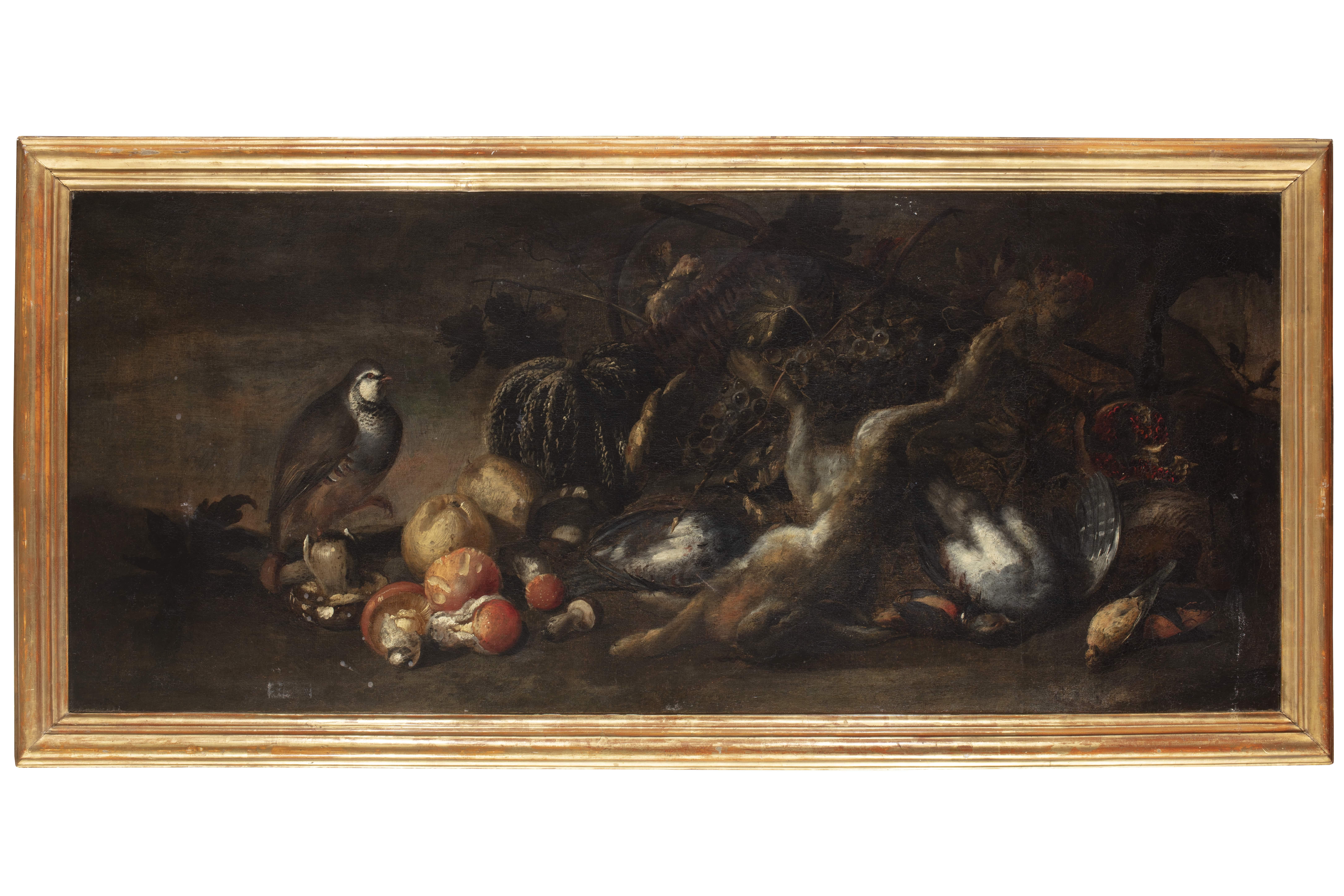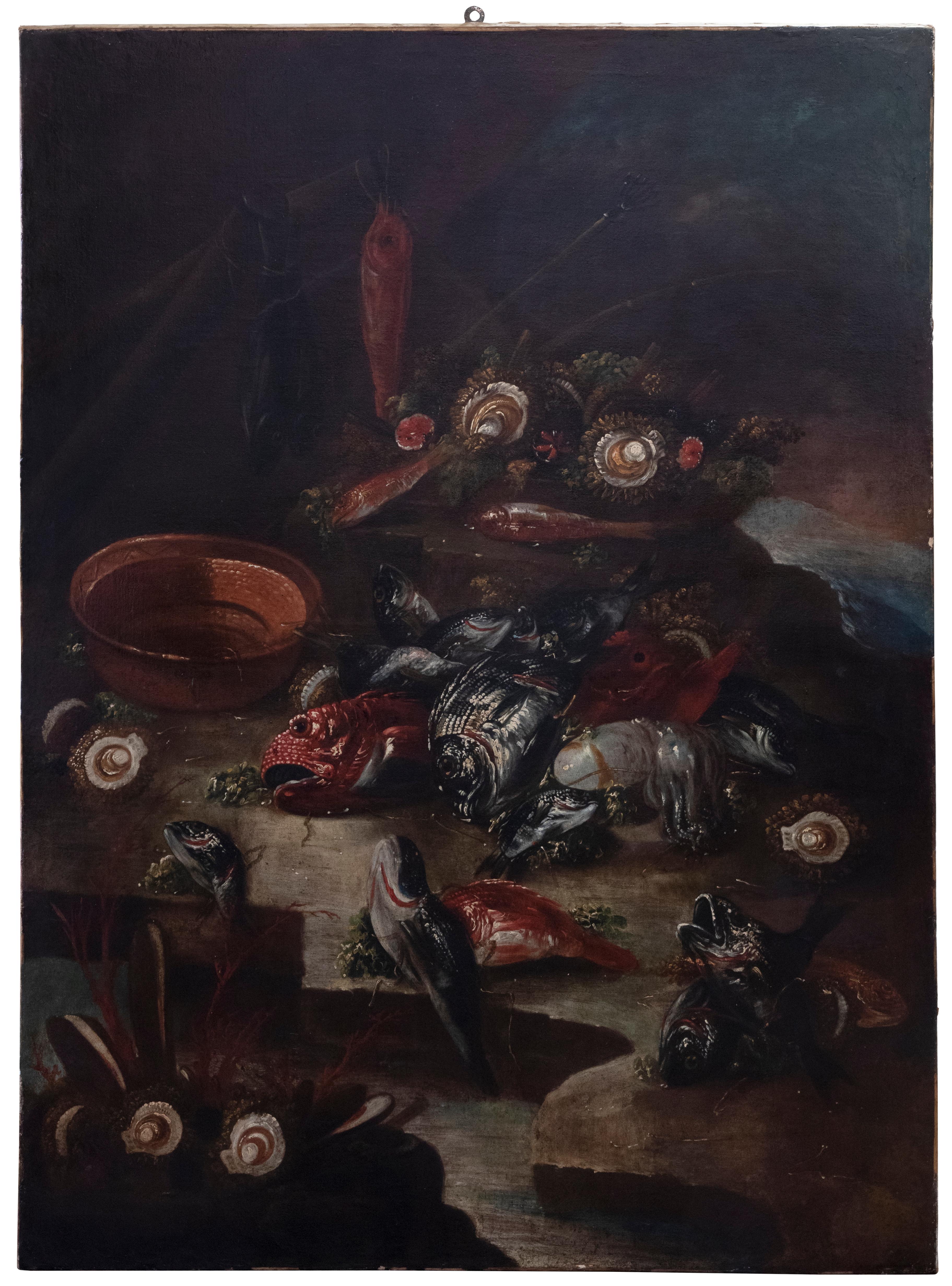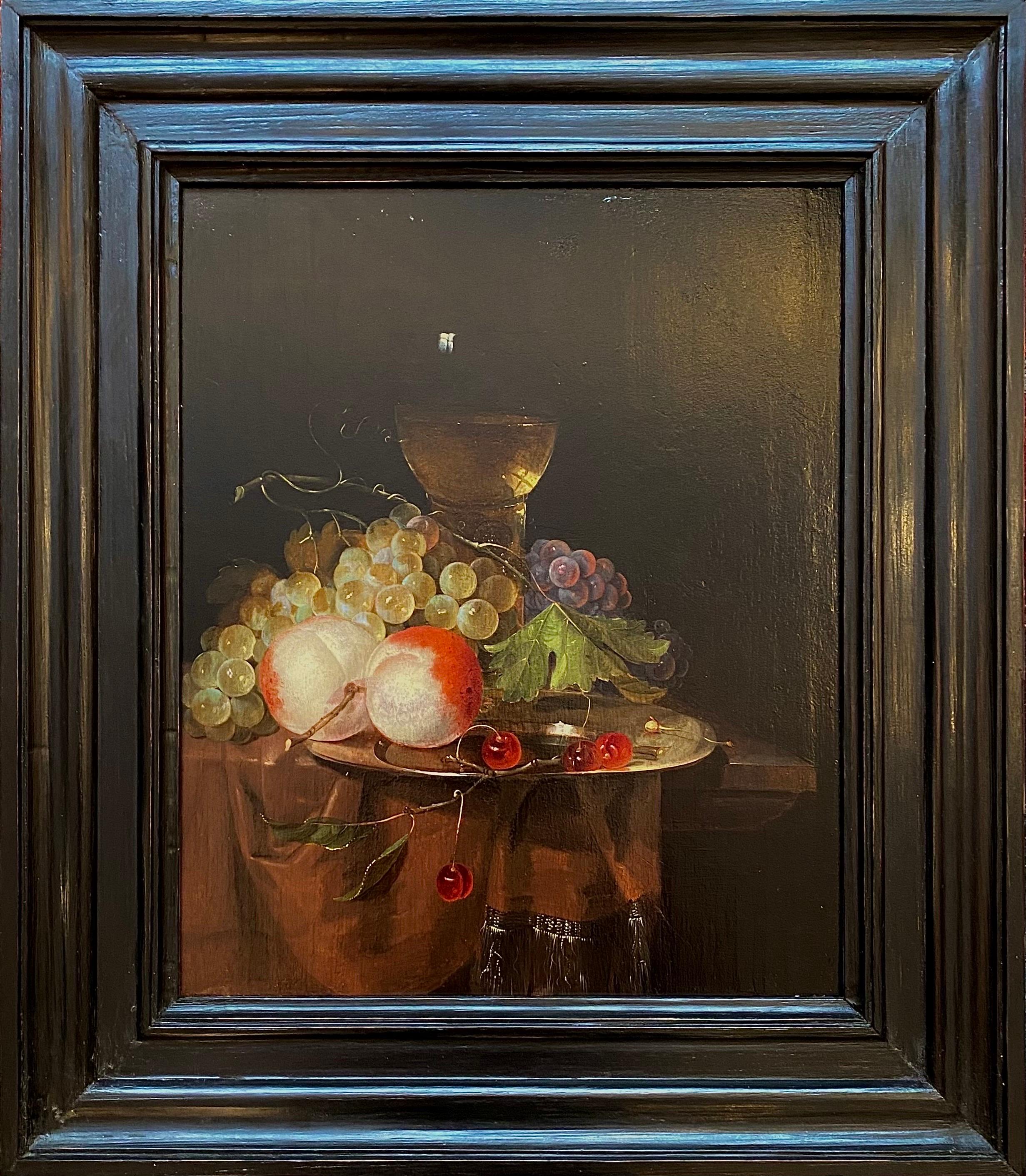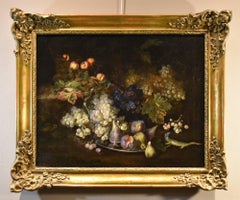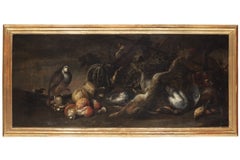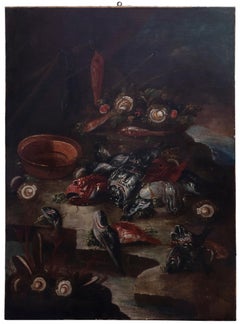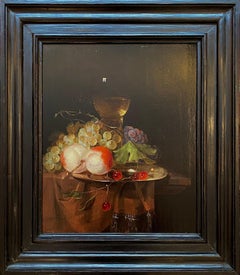Items Similar to Still Life Adriaenssen Paint 17th Century Oil on canvas Old master Flemish
Video Loading
Want more images or videos?
Request additional images or videos from the seller
1 of 19
Still Life Adriaenssen Paint 17th Century Oil on canvas Old master Flemish1610-1660
1610-1660
$16,906.78
$21,133.4720% Off
£12,508.90
£15,636.1320% Off
€14,040
€17,55020% Off
CA$23,376.63
CA$29,220.7820% Off
A$25,664.62
A$32,080.7820% Off
CHF 13,389.29
CHF 16,736.6120% Off
MX$310,577.64
MX$388,222.0520% Off
NOK 167,813.94
NOK 209,767.4220% Off
SEK 158,124.85
SEK 197,656.0620% Off
DKK 106,900.95
DKK 133,626.1920% Off
About the Item
Alexander (Van) Adriaenssen (Antwerp, 1587 - 1661)
Still life with oysters, fish and lobsters
Oil on canvas (67 x 110 cm - In frame 87 x 131 cm)
Expertise by Prof Massimo Pirondini (Reggio Emilia)
Oysters, various types of fish and two lobsters are arranged on a smooth stone surface. In the background, there is a copper pot, a large wicker basket and barrels for brine (one with the letters B V, legible upside down).
The distinctive characteristics of the painting reveal it to be the product of the particular historical and cultural environment that emerged in the Netherlands between the late 16th and early 17th centuries, when the genre of “still life” achieved extraordinary importance as the absolute protagonist, rather than a marginal accessory, of works of art.
Dutch still life, whether of flowers, fruit, game, tableware or everyday objects, tended to focus on simple, domestic themes, almost as if to represent the deep love of its people for the reality of the humble, everyday things in life. This was in contrast to the Flemish style, which, on the contrary, became increasingly theatrical, pompous and “plénitude débordante”.
The “Still Life with Oysters, Fish and Lobsters” considered here fully reflects the Dutch inclination, with its sober figuration and essential composition. In particular, if we analyse the orderly spatial arrangement of the objects, we can easily attribute the painting to Alexander von Adriassen (Antwerp, 1587 - 1661), whose catalogue shows clear stylistic similarities with our painting.
His favourite subjects and recurring themes were fish, shellfish, oysters and, sometimes, game or vegetables placed on simple kitchen tables. Although he remained in Flemish Antwerp, not far from the Dutch border, he was undoubtedly influenced by it in his choice of content and compositional frugality.
In his compositions, he carefully arranged individual objects to create a sense of balance and harmony in the painting, and his use of “empty space” is also remarkable, calibrated to highlight and give importance to what he was depicting.
This work of art is a perfect example of the artist's ability to capture the authenticity of everyday food in a natural way: it looks like a photograph of a table in a 17th-century Dutch middle-class home, depicted without too many frills.
Born in Antwerp in 1587, Alexander was already registered in 1610 as a master specialising in still life at the Guild of Saint Luke in his city, earning the admiration of Rubens, who had several of his works in his collection, and Anthony van Dyck, with whom he was also friends and collaborated.
His works can be found in numerous European museums, including the Nationalmuseum in Stockholm, the Rijsmuseum in Amsterdam, the Koninklijk Museum in Antwerp and the Prado in Madrid. The latter, in particular, houses a beautiful series from the Spanish royal collections, including a “Still Life with Fish, Oysters and a Cat”. (1)
Finally, as regards the letters V B on the barrel in the background, it is unlikely that they are the artist's initials, but more likely a mark originally engraved on the container, reproduced with the letters reversed by the artist as he saw them when painting from life, as was often the case, with the aid of a mirror.
ADDITIONAL INFORMATION:
The painting is sold complete with a pleasant antique frame and is accompanied by a certificate of authenticity and a descriptive iconographic card.
We take care of and organise the transport of purchased works, both in Italy and abroad, through professional and insured carriers.
If you would like to see this or other works in person, we would be delighted to welcome you to our new gallery in Riva del Garda, at Viale Giuseppe Canella 18. We look forward to seeing you!
Please contact us for any information or to arrange a visit, we will be happy to assist you.
- Attributed to:Alexander Van Adriaenssen (antwerp, 1587 - 1661)
- Creation Year:1610-1660
- Dimensions:Height: 34.26 in (87 cm)Width: 51.58 in (131 cm)
- Medium:
- Movement & Style:
- Period:
- Condition:
- Gallery Location:Riva del Garda, IT
- Reference Number:1stDibs: LU988116524632
About the Seller
4.9
Platinum Seller
Premium sellers with a 4.7+ rating and 24-hour response times
Established in 2017
1stDibs seller since 2018
260 sales on 1stDibs
Typical response time: <1 hour
- ShippingRetrieving quote...Shipping from: Riva del Garda, Italy
- Return Policy
Authenticity Guarantee
In the unlikely event there’s an issue with an item’s authenticity, contact us within 1 year for a full refund. DetailsMoney-Back Guarantee
If your item is not as described, is damaged in transit, or does not arrive, contact us within 7 days for a full refund. Details24-Hour Cancellation
You have a 24-hour grace period in which to reconsider your purchase, with no questions asked.Vetted Professional Sellers
Our world-class sellers must adhere to strict standards for service and quality, maintaining the integrity of our listings.Price-Match Guarantee
If you find that a seller listed the same item for a lower price elsewhere, we’ll match it.Trusted Global Delivery
Our best-in-class carrier network provides specialized shipping options worldwide, including custom delivery.More From This Seller
View AllStill Life Animals Fruit De Gryef Signed Paint 17th Century Oil on canvad Art
Located in Riva del Garda, IT
Adriaen de Gryef (Leiden 1657 - Brussels 1722)
Signed ‘A Gryeff f’(ecit) - centre left
Peasant in the courtyard with still life of animals and fruit
Oil on canvas
Dimensions (cm): ...
Category
17th Century Old Masters Paintings
Materials
Oil
$7,388 Sale Price
20% Off
Still Life Vanitas Noletti Paint Oil on canvas Old master 17th Century Italian
Located in Riva del Garda, IT
Francesco Noletti known as the Maltese (Malta 1611-Rome 1654) Workshop/circle of
Still life with musical instruments, toys, armour, textiles and precious objects
Oil on canvas (52 x 78 cm. - in frame 71 x 102)
This painting, of beautiful scenic effect, depicts a still life composed of a rich display of precious objects, arranged with an apparent disorder, one part on a table and the other on the floor, all theatrically behind a hanging drape from which tassels swing.
Among the objects, our author has reproduced we can see parts of a parade armour with gold borders, jugs and plates...
Category
17th Century Old Masters Paintings
Materials
Oil
$9,643 Sale Price
20% Off
Still-Life Flowers Ascione 17/18th Century Paint Oil on canvas Old master Italy
Located in Riva del Garda, IT
Aniello Ascione
(Naples, news from 1680 to 1708)
Still life with festoon of flowers and fruit
Oil painting on canvas
89 x 117 cm - in frame 104 x 132 cm.
With expertise and attrib...
Category
17th Century Old Masters Paintings
Materials
Oil
$18,660 Sale Price
20% Off
Still-Life Flower Von Tamm 17/18th Century Paint Oil on canvas Old master Italy
Located in Riva del Garda, IT
Franz Werner Von Tamm known as Monsieur Daparait (Hamburg 1658-Vienna 1754) Attributed to
Still life of fruit with lizard
Oil on canvas,
58 x 74 cm.
Framed 76 x 92 cm.
This magnifi...
Category
Early 17th Century Old Masters Paintings
Materials
Oil
$8,641 Sale Price
20% Off
Still-Life Flower Von Tamm 17/18th Century Paint Oil on canvas Old master Italy
Located in Riva del Garda, IT
Franz Werner Von Tamm known as Monsieur Daparait (Hamburg 1658-Vienna 1754) Attributed to
Still life of fruit with lizard
Oil on canvas,
58 x 74 cm.
Framed 76 x 92 cm.
This magnifi...
Category
Early 17th Century Old Masters Paintings
Materials
Oil
$8,641 Sale Price
20% Off
Pieter Casteels III 'Signed' Floral Still Life Old master Paint 18th Century Art
By Pieter Casteels III (Antwerp 1684 - 1749 Richmond)
Located in Riva del Garda, IT
Pieter Casteels III (Antwerp 1684 - 1749 Richmond) circle
Floral still life
Signed lower left, on the stone: P Casteels
About 1730
Oil painting on...
Category
18th Century Old Masters Paintings
Materials
Oil
$15,497 Sale Price
40% Off
You May Also Like
Late 17th Century By Still-life Italian painter Still life Oil on Canvas
Located in Milano, Lombardia
17th Century Still-life Italian painter
Title: Still life
Medium: Oil on canvas
Dimensions: without frame 58 x 136 cm - with frame 71.5 x 150 cm
Antique shaped and gilded wooden box...
Category
17th Century Old Masters Still-life Paintings
Materials
Oil, Canvas
Still Life with Fishes and Oysters - Oil on Canvas - 17th Century
Located in Roma, IT
Still life with fishes and oysters is an original oil on canvas realized in the 17th Century by Neapolitan School Master.
Impressive in size as well as for its vivid representation o...
Category
17th Century Old Masters Still-life Paintings
Materials
Oil
Still Life, 17th Century Oil on Panel Painting
Located in London, GB
Oil on panel, monogrammed mid left
Image size: 15 x 12 1/4 inches (38 x 31 cm)
Dutch ripple style frame
Loeding was born in Leiden in around 1637 and was admitted into the Leiden Guild of St Luke in 1664. Like other Dutch cities, Leiden required membership in the guilds in order to sell wares falling under the various specifications. There is no record of his artistic training or influences, but he likely belonged to the circle of artists including Pieter de Ring and Gerrit Dou, who founded and maintained the Guild. Loeding is last registered as a member in 1673.
One of the most versatile genres that emerged from Dutch 17th Century artistic specialisms is that of 'pronkstilleven'; a laden table with a variety of rich textures, like ornate glassware, gilded goblets, exquisite nautilus cups...
Category
Mid-17th Century Still-life Paintings
Materials
Oil, Panel
Still Life of Fruit - Dutch 17th century art Old Master still life oil painting
By Jan Davidsz. de Heem
Located in Hagley, England
This stunning Dutch 17th century Old Master still life oil painting is attributed to the circle of Jan Davidsz de Heem. Painted circa 1660 it is a magnificent vibrant painting of gra...
Category
17th Century Old Masters Still-life Paintings
Materials
Oil
$9,374 Sale Price
20% Off
"Still Life with Fruits", 17th Century Oil on Canvas by Flemish School
Located in Madrid, ES
FLEMISH SCHOOL
17th Century
STILL LIFE WITH FRUITS
unsigned
oil on canvas
17-3/4 x 21-3/4 inches (45 x 55 cm.)
framed: 22 x 27 inches (56 x 68 cm.)
PR...
Category
17th Century Flemish School Still-life Paintings
Materials
Canvas, Oil
STILL LIFE - Giovanni Perna - Dutch School - Oil on Canvas Italian Painting
By Giovanni Perna
Located in Napoli, IT
Still life - Giovanni Perna Italia 2006 - Oil on canvas cm.60x80
In this beautiful oil on canvas Giovanni Perna was inspired by the paintings of the Spanish painter of Dutch origin ...
Category
Early 2000s Old Masters Still-life Paintings
Materials
Canvas, Oil
More Ways To Browse
Antique Letters
Antique Saw
Flemish Paintings
Old Master Flemish
Dutch Old Master Still Life Painting
Antwerp Art
Flemish Masters
Flemish Oil Painting
16th Century Old Master Painting
Flemish Frame
Still Life Vegetables Oil Painting
Lobster Antique
Dutch Master Oil Painting Flowers
Antique Flemish Frame
17th Century Flemish Painting
Fruit Basket Still Life Painting
Still Life Painting Antique Fruit
Large 16th Century Oil Paintings
